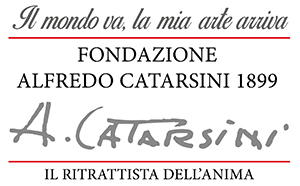ALFREDO CATARSINI – PAINTER AND WRITER
Viareggio, 17 January 1899 – 28 March 1993
BRIEF BIOGRAPHICAL NOTES
Alfredo Catarsini was born in Viareggio, in the shadow of the Matilde Tower, in the house that belonged to Ippolito Ragghianti, on January 17, 1899. Start painting very early. He is still a boy when he goes to Paris where he meets Amedeo Modigliani.
Lorenzo Viani considered him one of the most interesting artists of Viareggio. In ’39 he won the “Cremona” prize and in ’40 – ’41 he represented Italian art in Hanover. In 42 he was invited to the XXIII Venice Biennale; in ’43 it was at the IV Roman Quadrennial. After the war, he participated in the Biennials of ’48 and ’50 and in the Quadrennials of ’52, ’56 and ’59.
His painting finds inspiration from the sea and from his land, with which he maintains a deep and irreplaceable love, which he translates into the suggestion offered by the docks with the yards, the boats, the sails, the caulkers, the fishermen. His long pictorial history – he died in Viareggio on 28 March 1993 – is always consistent with his training, which translates into landscapes, portraits, female figures, still lifes.
Silent and sweet observer of the human environment, in its natural context, he makes Garibaldo Alessandrini say, as early as 1942, “… admirable for the chastity of the design and vigorous harmony.”
Throughout the twentieth century, he perceives their innovative turmoil, studies them, experiences “isms” and currents. Its two periods, “Reflessismo” and “Simbolismo meccanico”, address the drama of the civilization of machines, of the alienation and loneliness of modern man.
After the war he taught at the “Stagio Stagi” Art Institute in Pietrasanta holding the chair of Drawing from Life.
Dynamic and tireless, he actively contributes to the cultural life of Versilia, he writes in newspapers and in Versilia Oggi and Versilia Ieri. In 1969 he published his first novel “Giorni Neri” set in Lucca during the period of displacement and the Resistance.
Between 1980 and 1992 he stayed for long periods in Lodi where, in 1990, he was awarded the prestigious “Arvini” prize.
His works are in public collections including the Modern Art Galleries of Milan, Ferrara, Florence, Rome, Lodi, Viareggio, Pietrasanta, Pisa, Paris and in the Munich Museum of Art.
Among others, Enrico Pea, Emanuele Bugatti, Everardo Dalla Noce, Paolo Levi, Tommaso Paloscia, Sergio Solmi, Pier Carlo Santini, Leonida Repaci, Mario Quadraroli, Alfonso Gatto, Krimer, Carlo Carrà, Raffaello Bertoli, Dino Carlesi, Enrico Dei, Nicola Micieli, Schneeberger, Raffaele De Grada, Bode, Mario De Micheli, Antonio Paolucci, Cristina Acidini, Vittorio Sgarbi.
To honor the great and long friendship that has linked him to Leonida Repaci since the birth of the Prize, one of his “Darsena” from the period of Reflessismo was chosen as the manifesto of the 70th anniversary of the Viareggio Repaci Prize.
In 2003 his Atelier was refurbished in the attics of the Palazzo Paolina Bonaparte in Viareggio, which he used for more than 50 years until his death. It is possible to visit his restored studio which houses works, photos and its historical archive reorganized by the Istituto Storico Lucchese.
Florence remembered him in 2005 with a retrospective exhibition curated by Antonio Paolucci and Raffaello Bertoli “Alfredo Catarsini, the Tuscan painter of emotion” at Palazzo Panciatichi.
His “Self-portrait of ’34” from September 2005 went to enrich the Uffizi Museum.
On 8 September 2006, 62 years after the distant 1944 when Catarsini was commissioned to paint the frescoes in the apse, thanks to the involvement of the parish priest Don Rossi, the restoration of the frescoes that Alfredo Catarsini had carried out in the church of S. Martino in Freddana: the same community has promoted the cleaning of the frescoes.
In the month of May of each year, the prize named after him is awarded to three students of the Higher Institutes of the Province of Lucca, winners of the “Drawing and Painting from true extempore” competition held in Viareggio.
A square in the city of Viareggio is named after him.
